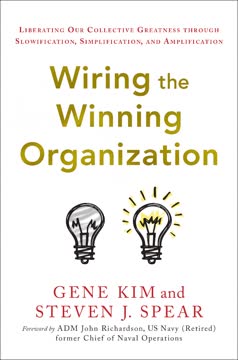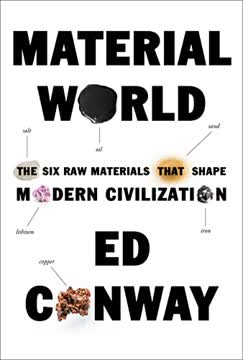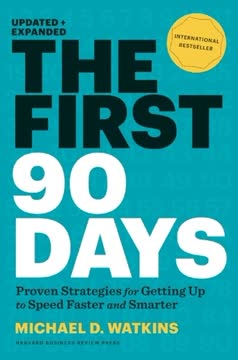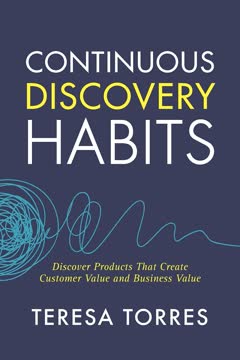نکات کلیدی
1. اصطکاک باعث ایجاد فاصله بین برنامهها، اقدامات و نتایج میشود
اصطکاک انجام کارهای ساده را دشوار و کارهای دشوار را غیرممکن میسازد
فاصله دانشی: سازمانها به دلیل اطلاعات محدود درباره محیط و رویدادهای آینده با عدم قطعیت مواجه میشوند. این منجر به برنامههای ناقصی میشود که ممکن است همه احتمالات را در نظر نگیرند.
فاصله همراستایی: حتی زمانی که برنامهها به خوبی طراحی شدهاند، اغلب بین آنچه رهبران قصد دارند و آنچه کارکنان واقعاً انجام میدهند، ناهماهنگی وجود دارد. این میتواند به دلیل سوءتفاهم، سوءتعبیر یا اولویتهای متضاد باشد.
فاصله اثرات: اقداماتی که توسط یک سازمان انجام میشود ممکن است به دلیل شرایط پیشبینینشده، واکنشهای رقبا یا پویاییهای پیچیده بازار نتایج مطلوب را به همراه نداشته باشد. این عدم پیشبینیپذیری در هر سیستم پیچیدهای ذاتی است.
2. فرصتطلبی هدایتشده سه فاصله در اجرای استراتژی را میبندد
استراتژی یک سیستم از تدابیر است. این بیش از علم است، این کاربرد دانش در زندگی عملی است، تکامل یک ایده مرکزی از طریق شرایط دائماً در حال تغییر.
رویکرد تطبیقی: فرصتطلبی هدایتشده رویکردی است که جهتگیری استراتژیک واضح را با انعطافپذیری برای تطبیق با شرایط در حال تغییر ترکیب میکند. این رویکرد به این واقعیت اذعان دارد که برنامههای کامل غیرممکن هستند و به جای آن بر ایجاد چارچوبی برای تصمیمگیری تمرکز میکند.
توانمندسازی کارکنان: این رویکرد به افراد اختیار میدهد تا در محدودههای تعریفشده تصمیمگیری کنند و به آنها اجازه میدهد به سرعت به فرصتها و چالشها پاسخ دهند.
یادگیری مستمر: با ارزیابی مداوم نتایج و تنظیم اقدامات، سازمانها میتوانند محیطهای نامطمئن را به طور مؤثرتری هدایت کنند. این یک چرخه یادگیری و تطبیق ایجاد میکند که اجرای استراتژی را در طول زمان بهبود میبخشد.
3. استراتژی یک ایده راهنمای در حال تکامل است، نه یک برنامه دقیق
هیچ برنامه عملیاتی نمیتواند با درجهای از اطمینان فراتر از اولین برخورد با بدنه اصلی دشمن گسترش یابد.
قصد استراتژیک: به جای تلاش برای ایجاد برنامههای دقیق بلندمدت، بر تعریف یک قصد استراتژیک واضح تمرکز کنید که جهتگیری را بدون تجویز بیش از حد فراهم کند.
انعطافپذیری: به این واقعیت اذعان کنید که شرایط تغییر خواهد کرد و آماده باشید تا استراتژی را با در دسترس قرار گرفتن اطلاعات جدید تطبیق دهید. این نیازمند تغییر ذهنیت از "برنامهریزی و اجرا" به "انجام و تطبیق" است.
ایده اصلی: در حالی که تاکتیکها و اقدامات خاص ممکن است تغییر کنند، یک ایده استراتژیک اصلی ثابت را حفظ کنید که تصمیمگیری را در همه سطوح سازمان هدایت کند. این انسجام را حتی در حالی که اقدامات فردی تکامل مییابند، فراهم میکند.
4. جهتگیری مؤثر بر قصد تمرکز دارد، نه مدیریت جزئیات
بیش از آنچه لازم است فرمان ندهید، یا فراتر از شرایطی که میتوانید پیشبینی کنید برنامهریزی نکنید
اهداف واضح: "چه" و "چرا"ی اهداف را به وضوح ارتباط دهید، اما در "چگونه" انعطافپذیری را اجازه دهید. این به افراد قدرت میدهد تا از قضاوت و تخصص خود برای دستیابی به اهداف استفاده کنند.
جزئیات مناسب: در سطوح پایینتر سازمان راهنماییهای خاصتری ارائه دهید، اما از مدیریت جزئیات خودداری کنید. سطح جزئیات باید متناسب با وضعیت و قابلیتهای تیم باشد.
اعتماد: فرهنگی از اعتماد ایجاد کنید که در آن رهبران با واگذاری اختیار راحت باشند و کارکنان احساس کنند که در چارچوب قصد استراتژیک قدرت ابتکار عمل دارند.
5. توجیه و بازتوجیه اطمینان از همراستایی و درک را فراهم میکند
آنچه گفته میشود هنوز شنیده نشده است. آنچه شنیده میشود هنوز درک نشده است. آنچه درک میشود هنوز باور نشده است. آنچه باور شده است هنوز تبلیغ نشده است. آنچه تبلیغ شده است هنوز عملی نشده است. آنچه عملی شده است هنوز کامل نشده است.
وضوح ارتباط: از یک فرآیند توجیه ساختاریافته استفاده کنید تا اطمینان حاصل شود که قصد استراتژیک در همه سطوح سازمان به وضوح ارتباط داده شده است.
فرآیند دوطرفه: یک سیستم بازتوجیه پیادهسازی کنید که در آن زیردستان درک خود از اهداف و اقدامات برنامهریزیشده خود را توضیح دهند. این امکان وضوح و تنظیم را فراهم میکند.
همراستایی سلسلهمراتبی: همانطور که فرآیند توجیه در سازمان به پایین حرکت میکند، هر سطح جزئیات بیشتری اضافه میکند در حالی که همراستایی با قصد کلی را حفظ میکند.
6. ساختار و فرهنگ سازمانی باید از اجرای استراتژی حمایت کند
هوش یک سازمان هرگز برابر با مجموع هوش افراد درون آن نیست
همراستایی ساختاری: اطمینان حاصل کنید که ساختار سازمانی اجرای استراتژی را تسهیل میکند نه اینکه مانع آن شود. این ممکن است نیاز به سازماندهی مجدد برای حذف موانع همکاری یا تصمیمگیری داشته باشد.
تناسب فرهنگی: فرهنگی را توسعه دهید که از رفتارها و ذهنیتهای مطلوب برای اجرای مؤثر استراتژی حمایت کند. این شامل تقویت ابتکار عمل، یادگیری از اشتباهات و تطبیق با تغییر است.
انتخاب و توسعه: افرادی را جذب و توسعه دهید که مهارتها و ذهنیت لازم برای موفقیت در محیط فرصتطلبی هدایتشده را دارند. این ممکن است نیاز به تغییر در شیوههای استخدام، آموزش و ارتقاء داشته باشد.
7. معیارها باید از استراتژی حمایت کنند، نه اینکه به یک وسواس تبدیل شوند
شما نمیتوانید سبک رهبری را با فرمان اداری تغییر دهید.
رویکرد متعادل: از معیارها برای نظارت بر پیشرفت و اطلاعرسانی تصمیمگیری استفاده کنید، اما اجازه ندهید که آنها به اهداف خود تبدیل شوند. به یاد داشته باشید که همه چیزهایی که مهم هستند قابل اندازهگیری نیستند.
همراستایی با قصد: اطمینان حاصل کنید که معیارهای استفادهشده با قصد استراتژیک همراستا هستند و رفتارهای مطلوب را تشویق میکنند. از عواقب ناخواسته ناشی از معیارهای ضعیف طراحیشده آگاه باشید.
انعطافپذیری: آماده باشید تا معیارها را با تغییر شرایط یا در صورت اثبات ناکارآمدی تنظیم کنید. هدف حمایت از اجرای استراتژی است، نه پایبندی سختگیرانه به معیارهای از پیش تعیینشده.
8. رهبری نیازمند تعادل بین فرماندهی، مدیریت و الهامبخشی است
کارگردان جدا، محاسبهگر و انعطافپذیر است؛ مدیر درگیر، واقعبین و عملگرا است؛ رهبر متعهد، پرشور و مصمم است
فرماندهی: جهتگیری استراتژیک واضحی تعیین کنید و تصمیمات کلیدی درباره تخصیص منابع و اولویتها بگیرید.
مدیریت: منابع را سازماندهی و کنترل کنید تا استراتژی به طور مؤثری اجرا شود. این شامل ایجاد سیستمها و فرآیندهایی است که از اجرا حمایت میکنند.
رهبری: افراد را الهامبخشید و انگیزه دهید تا به قصد استراتژیک متعهد شوند و بهترین تلاشهای خود را ارائه دهند. این شامل ارتباط یک چشمانداز جذاب و ایجاد فرهنگی از اعتماد و توانمندسازی است.
تعادل موقعیتی: به این واقعیت اذعان کنید که موقعیتهای مختلف ممکن است نیاز به تأکید بر جنبههای مختلف این سهگانه داشته باشند. مدیران مؤثر باید بتوانند در صورت نیاز بین این نقشها جابجا شوند.
آخرین بهروزرسانی::
FAQ
What's The Art of Action about?
- Focus on Execution: The Art of Action by Stephen Bungay emphasizes the importance of executing strategy effectively in organizations, exploring the gaps between plans, actions, and results.
- Military Insights: The book draws on military history, particularly the Prussian Army's strategies, to illustrate leadership principles applicable to modern business.
- Directed Opportunism: Bungay introduces "directed opportunism," encouraging leaders to set clear intentions while allowing flexibility in execution to adapt to changing circumstances.
Why should I read The Art of Action?
- Practical Application: The book provides practical techniques for leaders to implement in their organizations, offering a framework for overcoming execution challenges.
- Historical Perspective: By linking military strategy to business practices, Bungay provides a unique perspective that can enhance understanding of leadership and organizational dynamics.
- Improving Performance: Reading this book can help identify and close gaps in strategy execution, leading to improved organizational performance and results.
What are the key takeaways of The Art of Action?
- Three Gaps Identified: Bungay outlines the knowledge gap, alignment gap, and effects gap, which are crucial for effective strategy execution.
- Importance of Intent: Strategy should be framed as an intent rather than a rigid plan, allowing for flexibility and adaptation.
- Empowerment and Trust: Leaders should empower teams to make decisions within a clear framework of intent, fostering trust and independent thinking.
What is "directed opportunism" in The Art of Action?
- Definition: Directed opportunism combines clear intent with flexibility to adapt actions as circumstances change, allowing organizations to seize unforeseen opportunities.
- Balancing Autonomy and Alignment: It emphasizes high levels of autonomy for individuals while maintaining alignment with organizational objectives.
- Practical Implementation: Organizations should create a culture where employees understand the intent behind their actions and feel empowered to make decisions.
How does The Art of Action relate military strategy to business?
- Historical Lessons: Bungay draws parallels between military strategy and modern business practices, arguing that military principles can be applied to organizational leadership.
- Concept of Friction: The book introduces "friction," referring to unpredictable challenges in both warfare and business, helping leaders navigate complexities.
- Leadership Principles: By examining historical military leaders, Bungay identifies key leadership principles that enhance decision-making and execution in business contexts.
What are the three gaps discussed in The Art of Action?
- Knowledge Gap: This gap is the difference between what leaders want to know and what they actually know when making plans, highlighting information limitations.
- Alignment Gap: The disconnect between what leaders want their teams to do and what they actually do, emphasizing the importance of clear communication.
- Effects Gap: The difference between intended effects of actions and actual outcomes, underscoring challenges in predicting action results in complex environments.
How can leaders close the knowledge gap as described in The Art of Action?
- Limit Planning Scope: Focus on planning only what can be realistically anticipated, allowing for flexibility in execution.
- Encourage Judgment: Empower teams to make decisions based on the best available information, fostering a culture of trust.
- Continuous Learning: Adopt a mindset of continuous learning, where teams reflect on outcomes and adapt strategies accordingly.
What techniques can be used to close the alignment gap in The Art of Action?
- Clear Communication of Intent: Articulate a clear intent outlining overall goals and objectives to ensure understanding.
- Backbriefing Process: Implement a backbriefing process for subordinates to confirm their understanding of directives and intentions.
- Empower Decision-Making: Empower teams to make decisions within the framework of the established intent, encouraging ownership and accountability.
How does The Art of Action suggest addressing the effects gap?
- Encourage Adaptability: Foster a culture that encourages individuals to adapt actions based on real-time feedback and changing circumstances.
- Focus on Outcomes: Prioritize outcomes over processes, ensuring teams understand desired results rather than just following prescribed actions.
- Continuous Monitoring: Implement systems for continuous monitoring of actions and effects, enabling timely adjustments to strategies.
What is the significance of "backbriefing" in The Art of Action?
- Ensures Understanding: Backbriefing ensures team members understand their tasks and objectives, allowing for clarification and alignment.
- Promotes Accountability: By confirming understanding, team members take ownership of responsibilities, fostering accountability.
- Facilitates Communication: Enhances communication within teams, reducing misunderstandings and ensuring alignment with expectations.
How does Bungay define the "three levels" of management in The Art of Action?
- Strategy Level: Focuses on long-term goals and overall direction, shaping the future of the organization.
- Operations Level: Translates strategic goals into actionable plans, considering resources and capabilities.
- Tactics Level: Involves execution of specific tasks and processes, supporting operational objectives.
What are the best quotes from The Art of Action and what do they mean?
- “No plan of operations can extend with any degree of certainty beyond the first encounter with the enemy’s main body.”: Emphasizes unpredictability in execution, suggesting adaptability is crucial once action begins.
- “The intelligence of an organization is never equal to the sum of the intelligence of the people within it.”: Highlights the importance of collaboration and communication, suggesting collective intelligence leads to better decision-making.
- “Clarity in intent is crucial for effective execution.”: Underscores the necessity of clear communication of goals and objectives for effective task execution.
نقد و بررسی
کتاب هنر اقدام به دلیل بینشهایش در زمینهی اجرای استراتژی، که شباهتهایی بین تاریخ نظامی و مدیریت کسبوکار ترسیم میکند، تحسینهای زیادی دریافت کرده است. خوانندگان تحلیل بونگی از شکافهای دانش، همراستایی و اثرات، و همچنین مفهوم "فرصتطلبی هدایتشده" او را میپسندند. این کتاب به خاطر ابزارهای عملی و مثالهای تاریخیاش مورد ستایش قرار گرفته است، اگرچه برخی آن را پیچیده و تکراری میدانند. بسیاری آن را برای رهبران و مدیران ضروری میدانند و درسهای ارزشمندی در مورد توانمندسازی تیمها در حالی که همراستایی استراتژیک حفظ میشود، ارائه میدهد. با این حال، برخی از منتقدان تشبیهات نظامی را بیش از حد میدانند.
Similar Books














